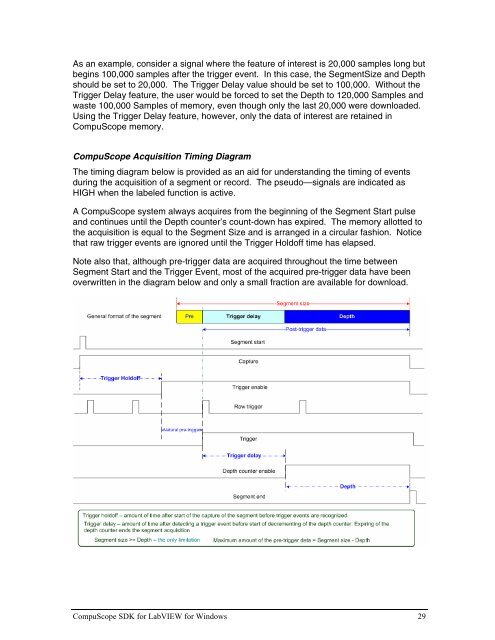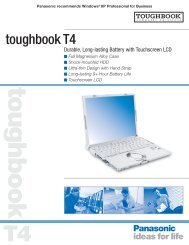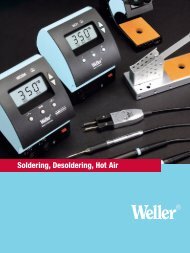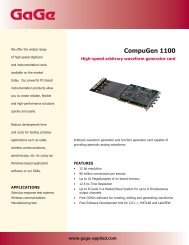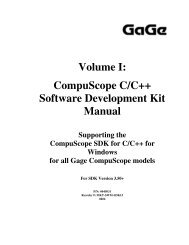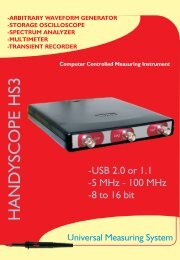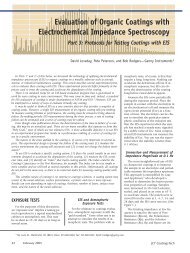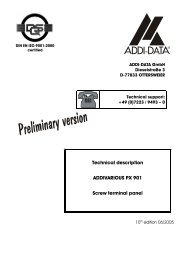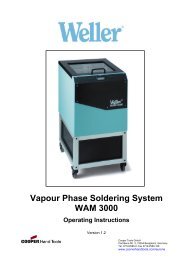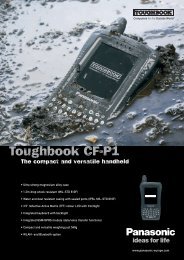accordingly reduce the maximum possible number of Multiple Records.Only newer <strong>CompuScope</strong> models such as the CS82G, CS12400, CS14200 andCS14105, support pre-trigger Multiple Record Mode. On older <strong>CompuScope</strong> modelswithout pre-trigger data in Multiple Record Mode, the Segment Size setting will have noeffect on a Multiple Record acquisition. The value is ignored and is <strong>for</strong>ced to be equal tothe Depth by the drivers.Trigger HoldoffTrigger Holdoff is a feature that is useful <strong>for</strong> ensuring the accumulation of a specifiedamount of pre-trigger data. The Trigger Holdoff setting specifies the amount of time, inSamples during which the <strong>CompuScope</strong> hardware will ignore trigger events afteracquisition has begun and pre-trigger data are being acquired.Without a non-zero Trigger Holdoff value, there is no guarantee that a given number ofpre-trigger samples will be acquired. This is because a trigger event may occurimmediately after acquisition, leading to a very small number of pre-trigger points. Byignoring trigger events <strong>for</strong> a time equal to the specified Trigger Holdoff value, theaccumulation of a number of pre-trigger points equal to the Trigger Holdoff setting isguaranteed.The downside of ensuring pre-trigger data with a non-zero Trigger Holdoff value is thattriggers are ignored, so that important trigger events may be missed. For instance, inlightning monitoring applications, researchers usually want to acquire pre-trigger data.These data give in<strong>for</strong>mation about signal behavior immediately preceding the lightningstrike, which triggers the <strong>CompuScope</strong> hardware. Lightning strikes may occur very closetogether in time, however, and missing a lightning pulse is much worse than missing pretriggerdata. Consequently, lightning testers should not use Trigger Holdoff but shouldsimply accept acquisitions of only the amount of pre-trigger data that naturally occurbetween triggers. Generally speaking, there<strong>for</strong>e, the user must decide whether to useTrigger Holdoff, based on the application.Trigger DelayNew-generation PCI <strong>CompuScope</strong> models such as the CS14200, CS14105 andCS12400, support a feature called Trigger Delay. This feature is useful <strong>for</strong> situationswhere the signal portion of interest occurs long after the trigger event.Normally, with a Trigger Delay of zero, the trigger event activates count-down of the posttriggerdepth counter, which was preloaded with the post-trigger depth. The counter isdecremented by one count <strong>for</strong> each sample acquired after the trigger event. When thecounter value reaches 0, the acquisition is terminated. In this way, the <strong>CompuScope</strong>acquires a number of samples equal to the depth after the trigger event.A non-zero Trigger Delay value is used to delay the beginning of the countdown of thepost-trigger depth counter. The Trigger Delay value sets the number of samples that the<strong>CompuScope</strong> hardware will wait after the trigger event occurs be<strong>for</strong>e beginning the countdownof the depth counters. The SegmentSize may be set equal to the depth so that the<strong>CompuScope</strong> hardware need not waste memory by storing data that are not of interest.28 <strong>CompuScope</strong> <strong>SDK</strong> <strong>for</strong> LabVIEW <strong>for</strong> Windows
As an example, consider a signal where the feature of interest is 20,000 samples long butbegins 100,000 samples after the trigger event. In this case, the SegmentSize and Depthshould be set to 20,000. The Trigger Delay value should be set to 100,000. Without theTrigger Delay feature, the user would be <strong>for</strong>ced to set the Depth to 120,000 Samples andwaste 100,000 Samples of memory, even though only the last 20,000 were downloaded.Using the Trigger Delay feature, however, only the data of interest are retained in<strong>CompuScope</strong> memory.<strong>CompuScope</strong> Acquisition Timing DiagramThe timing diagram below is provided as an aid <strong>for</strong> understanding the timing of eventsduring the acquisition of a segment or record. The pseudo—signals are indicated asHIGH when the labeled function is active.A <strong>CompuScope</strong> system always acquires from the beginning of the Segment Start pulseand continues until the Depth counter’s count-down has expired. The memory allotted tothe acquisition is equal to the Segment Size and is arranged in a circular fashion. Noticethat raw trigger events are ignored until the Trigger Holdoff time has elapsed.Note also that, although pre-trigger data are acquired throughout the time betweenSegment Start and the Trigger Event, most of the acquired pre-trigger data have beenoverwritten in the diagram below and only a small fraction are available <strong>for</strong> download.<strong>CompuScope</strong> <strong>SDK</strong> <strong>for</strong> LabVIEW <strong>for</strong> Windows 29


